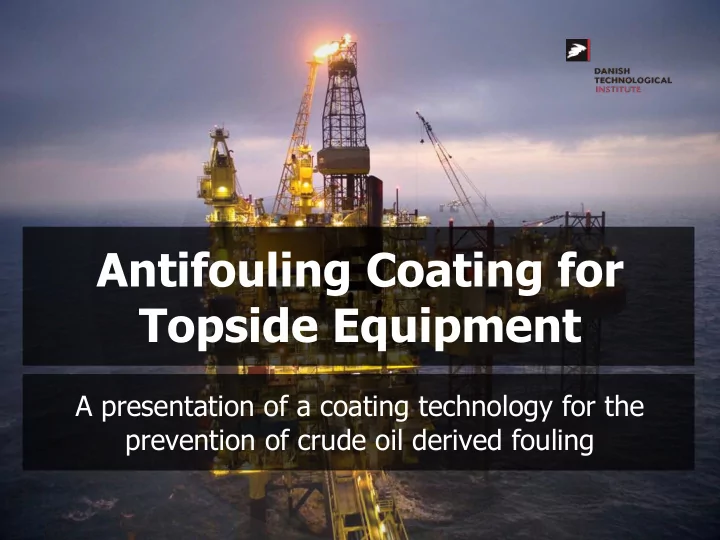

Antifouling Coating for Topside Equipment A presentation of a coating technology for the prevention of crude oil derived fouling
Outline Introduction to Sol-Gel technology Coating of Plate Heat Exchangers for Crude Oil Pilot Plant Coating Facility Status of today
The Sol-Gel process What is the Sol-Gel process? OR OR +4n H 2 O OH OH The term Sol-Gel describes a technology for katalysator RO RO Si Si OR OR HO HO Si Si OH OH the synthesis of glass ceramic coatings from -4n ROH OR OR OH OH liquid reagents. n n -2n H 2 O Traditional Glass ceramics: Solid components are sintered at a very high O O O O T to obtain fully inorganic glass ceramic O Si O Si O Si O Si O coatings. High strength, poor flexibility, no O O O O ‘specialized’ functions. O Si O Si O Si O Si O O O O O Sol-Gel technology: O Si O Si O Liquid reagents form at glass ceramic O O coating. Cures at low T. Less hard, but more flexible than traditional. Possible to obtain coatings with highly specialized physical/chemical properties.
The Sol-Gel term Why is it called Sol-Gel? The Sol-Gel technology is founded on colloidal chemistry. Colloids are ‘ stable systems, where one material is evenly distributed in another material’ The disperged phase (“the solubilized") Media/Phase Gas Liquid Solid None Liquid aerosols Solid aerosols Gas The (All gasses can be mixed) (fog, spray, etc.) (smoke, clods, etc.) continuous Foam Emulsion Sol Liquid phase (whipped cream, etc.) (milk, mayonnaise, etc.) (ink, blood, etc.) (”the solvent") Solid Foam Gel Cured Sol Solid (PUR, styrofoam , aerogel,…) (agar, gelatin, gelé, etc.) (ruby glass) The Sol-Gel term is derived from the fact that the two colloidal steps are present in the formation of glass ceramic coatings formed from this particular process.
Introduction to the Sol-Gel technology Quartz and crystal glass are primarily made up of Si and O atoms arranged in a perfect crystalline structure. ‚ Sol-Gel technology Naturally occurring quartz crystal Silicium Oxygene
Introduction to the Sol-Gel technology Amorphous glass Inorganic Contains eg. sodiumcarbonate Ordinary glass (window panes, etc) Can be produced by a Sol-Gel process Superior optical properties Brittle Telescope lenses Obsidian: Naturally occurring amorphous glass Coated telescope lens Silicium Oxygene
Introduction to the Sol-Gel technology Hybrid Sol-Gel glass ceramics Amorphous Organic and inorganic Organic component = functionality, e.g.: Easy-release Hydrophobic/hydrophilic Anti-graffiti Flexibility Si Si + Si Si OH Reaction between Epoxy og Amine Silicium Oxygene
Introduction to the Sol-Gel technology General characteristics of the Sol-Gel based glass ceramic coatings: Thin (3-15 µm) Transparent Flexible Good adhesion to different materials Ra = 0.3 nm Four ‘handles’ for the formulation of Sol -Gel coatings: The in-organic, glass-ceramic matrix Surfactant, additives ‘Organic modified silanes’ – ORMOSILS Solid fillers Enables the development of coatings with customized features: Repellent Ra = 6 nm Low surface energy Smooth Application: Spray, dipping, spinning, etc. Curing at 200 °C Ra = 300 nm
Research and Development of Crude Oil Repellent Coating CORE Coat 010 was adapted and lab-tested under relevant parameters Extract from test regiment • Stability to crude oil (RT and 50 °C) • Adhesion to ss, Ti og Al • 1000 hr Salt spray testing, Atlas Cell testing • Flexibility • Heat Conductivity (reduction of PHE efficiency) • Contact point wear Uncoated CORE Coat 010
Crude Oil Repellent Coating Offshore Tests 2009 Based on laboratory tests, the two best performing coating systems were chosen for preliminary offshore tests on 30 Alfa Laval M20 plates: 15 x CORE Coat 010 15 x CORE Coat 020 • Operational for seven months in the North Sea • Surveillance by thermographic camera and laser thermometry • Disassembly and inspection
Crude Oil Repellent Coating Offshore use Inspection of PHE plates after 7 months of operation CORE Coat 010 og 020 provide superior repellent properties towards both organic and inorganic fouling CORE Coat 010 exhibits the superior adhesion and integrity CORE Coat 020 exhibits slightly inferior properties compared to CORE Coat 010 Since, thousands of plates have been coated with CORE Coat 010 and excellent data have been retrieved. Efficiently repels crude oil fouling (organic and inorganic components) – approx. 1000 days offshore Is stable in contact with crude oil Has proven effect on Ti PHE units for crude oil cooling
Status Today CORE Coat 010 (Crude Oil Repellent Coating 010): Pilot production facility established in 2010 Flexible production – permits new coatings assignments with short notice Cooperation with Alfa Laval on PHE application Coating of new and old plates possible ISO9001 certifiability in process
Status Today CORE Coat 010 (Crude Oil Repellent Coating 010): Focus on environmental impact ISO14001 certifiability in process Documentation available on Environmental Impact HSE CORE Coat 010 is not formulated from nano-particles CORE Coat 010 does not contain any fluorated compounds
Please contact us for further information
Recommend
More recommend